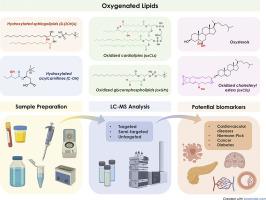Trends in Analytical Chemistry ( IF 11.8 ) Pub Date : 2021-06-16 , DOI: 10.1016/j.trac.2021.116367 Alma Villaseñor , Joanna Godzien , Tomás Clive Barker-Tejeda , Carolina Gonzalez-Riano , Ángeles López-López , Danuta Dudzik , Ana Gradillas , Coral Barbas

|
Great advances in lipidomics during the last years have opened the door to a broader knowledge of oxygenated lipids. These substances are derived either from the inclusion of previously hydroxylated fatty acids in the lipid structure of sphingolipids and acyl-L-carnitines, or by enzymatic and non-enzymatic modifications (oxidized lipids) of glycerophospholipids (including cardiolipins), cholesteryl esters and cholesterol. Despite their significance in the regulation of multiple diseases such as cancer or diabetes, the number of experimentally detected oxygenated lipids remains relatively low. This is in part due to the main challenges in their analysis, which are their low natural concentrations, their wide diversity of physicochemical properties, presence of isomers, and their a priori unknown presence in the biological samples. In particular, analysis of oxidized lipids, especially peroxides, has become a daunting task in liquid chromatography coupled to mass spectrometry (LC-MS) due to their high chemical and thermal instability, and the potential for further propagation of lipid oxidation and eventual degradation. The aim of this review is to highlight the experimental conditions on sample preparation procedures, the LC-MS based analytical approaches for identification and quantification of oxygenated lipids, and their relation as potential biomarkers in diseases based on the most relevant articles published in the last five years. Regarding sample preparation, special attention has been given to antioxidants, internal standards, extraction and concentration methods, and derivatization approaches. Moreover, targeted, semi-targeted and non-targeted strategies have been discussed presenting examples. Finally, considerations on the structural identification, one of the main challenges, are presented.
中文翻译:

通过 LC-MS 研究含氧脂质以寻找潜在生物标志物的分析方法
过去几年脂质组学的巨大进步为更广泛的含氧脂质知识打开了大门。这些物质来源于鞘脂和酰基-L-肉碱的脂质结构中包含先前羟基化的脂肪酸,或甘油磷脂(包括心磷脂)、胆固醇酯和胆固醇的酶促和非酶促修饰(氧化脂质)。尽管它们在调节多种疾病(如癌症或糖尿病)中具有重要意义,但实验检测到的含氧脂质的数量仍然相对较低。这部分是由于他们分析中的主要挑战,即它们的天然浓度低、理化性质的广泛多样性、异构体的存在以及它们的先验生物样品中的未知存在。特别是氧化脂质,尤其是过氧化物的分析,由于其化学和热不稳定性高,以及脂质氧化和最终降解的进一步传播潜力,已成为液相色谱-质谱联用 (LC-MS) 中一项艰巨的任务。本综述的目的是强调样品制备程序的实验条件、基于 LC-MS 的含氧脂质鉴定和定量分析方法,以及它们作为疾病潜在生物标志物的关系,基于最近五篇发表的最相关的文章。年。在样品制备方面,我们特别关注抗氧化剂、内标、提取和浓缩方法以及衍生化方法。此外,有针对性的,已经通过示例讨论了半靶向和非靶向策略。最后,提出了对结构识别的考虑,这是主要挑战之一。











































 京公网安备 11010802027423号
京公网安备 11010802027423号